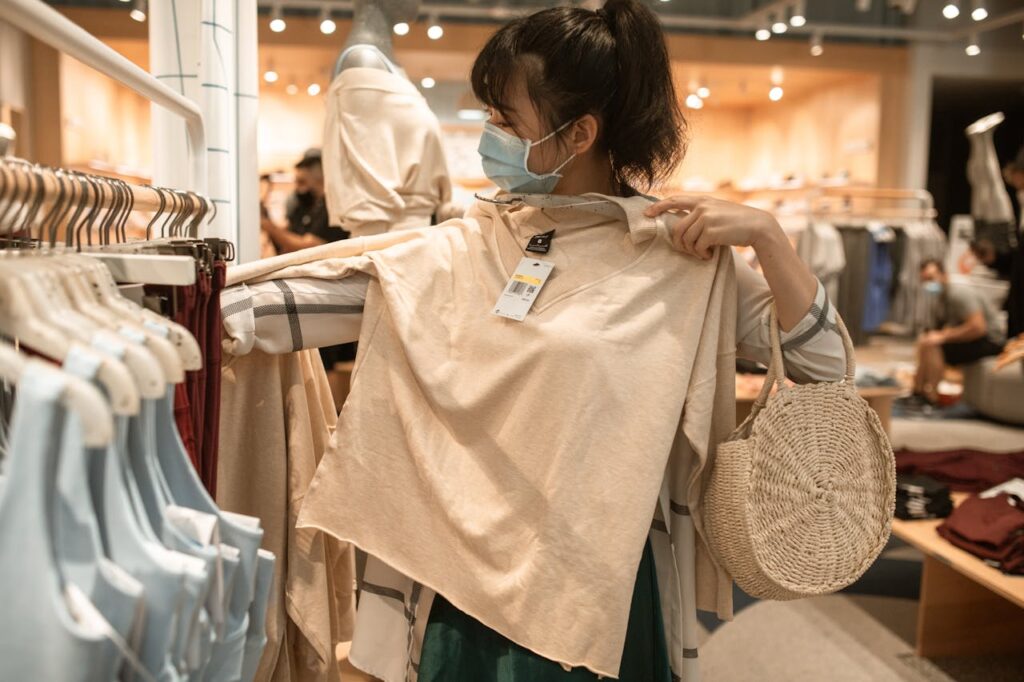Whether or not you know it, fast fashion is slowly destroying the world around you. The environmental impact of fast fashion can be devastating. But first, let’s understand fast fashion. What is it exactly?
Fast fashion means the business of rapidly changing trendy fashion designs and the continuous production of clothing and accessories. Usually, fashion and clothing companies make low-cost fashion products and quickly bring them to the market to take advantage of growing demand.
It means that a huge amount of cheap but trendy clothing is produced in a short amount of time. These clothes go to waste after a short time, when new fashion trends arrive. So, a large amount of fashion waste is generated around the world from fashion.
But that’s not all! The continuous mass production of fashion items leads to low wages and unfair working conditions in factories around the world.
So, quite naturally, this form of fashion can be very harmful for the planet in the near future. Let’s discuss the problems with fast fashion and whether sustainable fashion brands can provide the solutions we need.
What are the Environmental Impacts of Fast Fashion? How Harmful Are They?

There are many different environmental impacts of the fast fashion industry. Over the years, this industry has contributed to a lot of environmental damage and pollution. These are some of the major impacts:
Fast Fashion and Climate Change
Fast fashion brands are some of the major producers of greenhouse gases in the world. The industry contributes to around 8-10% of emissions globally. Production, manufacturing, and transport of clothing cause more emissions.
Water Pollution from the Fashion Industry
The traditional fashion industry contributes to more water pollution. Harmful chemicals from dyes and synthetic fabrics are released into natural waterways, polluting them. Both the production and disposal of clothing pollute the water.
More Fashion Waste
As fashion trends keep on changing, customers pile up more clothes. Sooner or later these clothes are dumped at landfills. Most of these waste clothes are never used again. The landfills keep getting bigger.
Microplastics Polluting The Environment
Fast fashion clothes are made of synthetic fibers and other cheap materials. They release microplastics into the environment. Not only do these plastics reach the oceans and pollute them, but they also cause harm to human health.
Shrinking Resource
Huge amounts of materials and other resources are needed to produce more clothes every day. Cotton farming requires large amounts of water. Moreover, a huge amount of chemical pesticides are used. It puts immense pressure on soil, water, minerals, and other resources.
Chemical Usage in Dyes
Harmful chemicals are used to make dyes for clothing. Especially, fast fashion uses a huge amount of chemical dyes to reduce production costs. These dyes drastically pollute water and soil. Harmful chemicals are also used for textile treatment.
Low Wages for Workers
To lower production costs, fast fashion has to rely on cheap labor from developing countries. These countries offer more opportunities for increasing profits. So, laborers are hired for bare minimum wages. It often leads to exploitation of labor.
Child Laborers
There have been serious allegations of child labor against many fast fashion brands. Shein revealed child labor cases in their supply chain in 2023. It is a major issue in cotton and garment supply chains around the world.
Bad Working Conditions
Factories that produce fast fashion clothes often have unsafe conditions for working. Many factories have no safety systems in place. Factory buildings are often old and accident-prone. There are little to no safety precautions in a large number of production units.
Overconsumption
One of the worst environmental impacts of fast fashion is the promotion of overconsumption. It encourages customers to buy more clothes more often. They are also likely to buy more clothes that they may need. Excess buying also leads to more wastage.
Low-quality Clothing and Apparel
Fast fashion is cheap. So, popular brands use low-quality fabrics to make more clothes that they can sell faster. These clothes are less durable and go to waste faster. The speed of fast fashion compromises on quality.
Can Sustainable Fashion Brands Save the World?

Now let’s come to the next important question. Can sustainable fashion brands be the answer to the problems of fast fashion? As of now, they seem to be the best way out.
Let’s discuss how they can help.
Sustainable Fashion Brands and Their Goals
The goals of sustainable fashion brands are to minimize the environmental harm caused by fast fashion. They also aim to provide better working conditions, ethical labor practices, and fair wages. These brands are moving away from fast fashion by using eco-friendly production methods.
Circular Fashion
To put it simply, circular fashion means using old clothing materials to make new clothes. So, the lifespan of old clothes is maximized as they are used to make new clothes. It’s also about designing clothes with more durability.
Promoting Alternative Fashion
The alternative to ‘fast fashion’ is ‘slow fashion.’ Thus, these sustainable brands are also called slow fashion brands. They promote a kind of fashion that is not focused on trends but on saving the environment.
Less Waste
These brands focus on creating less waste. They minimize fabric waste during production by using eco-friendly materials. Moreover, they make their production processes more water-efficient.
Environmentally Friendly Materials
Sustainable clothing brands use materials like organic cotton, hemp, and recycled polyester. They also use newly invented fabrics like Tencel ™ , Piñatex, and Circulose. Some brands also use vegan leather.
Ethical Labor
Sustainable brands like Patagonia, Eileen Fisher, People Tree, Everlane, and others provide better working conditions and wages for all their workers. They have strong ethical workplace guidelines that their suppliers need to follow.
Better Working Conditions
Reformation is a company that aims to provide a fair working environment with safety, equality, and diversity. Many other sustainable brands also follow or are adopting their practices for building better workplaces for their employees.
Challenges for Sustainable Fashion Brands
Sustainable brands have their challenges in a world still dominated by fast fashion. The value-added production process often comes at a heavier cost of production. So, slow fashion is not as cheap as fast fashion. Sourcing materials, creating and managing transparent supply chains, and lowering product pricing are very critical challenges faced by them.
Greenwashing
Many ‘fast fashion’ brands that want to be more ‘sustainable’ are greenwashing their production processes. Greenwashing is a misleading practice in marketing where a company shows its products to be eco-friendly. It is done mainly to get public support. However, they exaggerate or make misleading claims about their products.
Conclusion: The Future of Fashion
It is a major challenge, as many fast fashion brands are practicing it to be counted among sustainable brands. However, it makes it difficult to separate brands that are actually sustainable from the ones that are pretending.
So, the future of fashion depends on how new-age brands approach the problems caused by fast fashion. We need more sustainable fashion brands that are dedicated to their environmental goals.
We also need fast fashion brands to slow down their production rate to leave more room for ethical fashion. Overall, an industry needs to be created where every brand is a sustainable brand.
There are many negative impacts of fast fashion. It causes waste, pollution, and exploitation. However, sustainable fashion practices can bring a change in the fashion industry, slowly but steadily.
As of now, sustainable brands may not be perfect. But they are our biggest hope for a brighter future.




Fast fashion is indeed a significant issue that demands urgent attention. The rapid production and disposal of trendy clothes not only harm the environment but also exploit workers in the process. It’s alarming to see how much water pollution and waste are generated by this industry. The release of microplastics from synthetic fabrics is particularly concerning, as it affects both marine life and human health. While sustainable fashion brands offer a potential solution, it’s unclear if they can keep up with the demand for trendy clothing. Do you think consumers are willing to pay more for sustainable options to make a real difference? How can we encourage people to shift their shopping habits towards more eco-friendly choices?